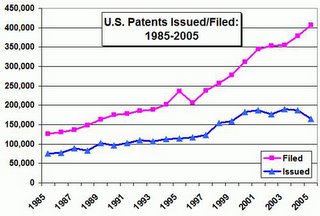The U.S. Patent and Trademark Office (PTO) has out its 2005 annual report, and it was another bumper year for volumes recorded on patnet filings.The USPTO hired a record 978 patent examiners, exceeding FY 2005 hiring goal by approximately 100 & also has plans to hire approximately 1,000 new examiners over the next year. Offices within the Patent organization perform activities essential to the patent process. At the front end, the Office of Initial Patent Examination (OIPE) performs the initial administrative review of newly filed applications. In FY 2005, OIPE received 380,9551 Utility, Plant, and Reissue (UPR) patent applications, 25,3471 Design applications, as well as 46,926 PCT applications. This represents a 7.2 percent increase over FY 2004 UPR filings; an 8 percent increase over FY 2004 design applications; and a 3 percent increase over FY 2004 PCT applications. Additionally, 111,672 provisional applications were received. In FY 2005, 152,090 UPR and 13,395 Design patents were granted and 291,221 pending applications were published. The USPTO hired a record 978 patent examiners, exceeding FY 2005 hiring goal by approximately 100 & also has plans to hire approximately 1,000 new examiners over the next year,Paul Kedrosky points out the sheer number of patents being filed for that a 406,300 number in 2005 represents:
In FY 2005, 152,090 UPR and 13,395 Design patents were granted and 291,221 pending applications were published. The USPTO hired a record 978 patent examiners, exceeding FY 2005 hiring goal by approximately 100 & also has plans to hire approximately 1,000 new examiners over the next year,Paul Kedrosky points out the sheer number of patents being filed for that a 406,300 number in 2005 represents:
• 1,846 filings/day
• 231 filings/hour
• 3.8 filings/minute
This may look satisfying to the Americans, as this seems to buck the emerging trend outlined by Richard Florida,who sees the rise of a new creative class.
No doubt impressive but I was all left wondering if this would ensure more competitiveness and ensure a steady rollout of new ideas, products, offerings. Earlier we covered why patent systems need to be disciplined and went to the extent of saying that its time to abolish patents for atleast software industry. On the other hand some people think that we have reached the dark age of innovation – Physicist Heubner says that rather than growing exponentially, or even keeping pace with population growth, major innovations & scientific advances peaked in 1873 and have been declining ever since. While examining number of patents granted in the US from 1790 to the present. when he plotted the number of US patents granted per decade divided by the country's population, he found the graph peaked in 1915. The global rate of innovation today, which is running at seven "important technological developments" per billion people per year, matches the rate in 1600. Despite far higher standards of education and massive R&D funding "it is more difficult now for people to develop new technology”.
As Michael Scrage recently wrote brilliantly, the simple fact is that R&D spending is an input, not a measure of efficiency, effectiveness or productivity. Ingenuity, invention and innovation are rarely functions of budgetary investment & pointed to the fact that Wal-Mart, Texco and Dell have miniscule R&D budgets, their quality, procurement and growth requirements have probably done more to drive productive innovation investment than any competing initiatives. Growing market competition, not growing R&D spending, is what drives innovation. A successful innovation policy is a competition policy where companies see innovation as a cost-effective investment to differentiate themselves profitably. John Hagel adds that it is a fallacy in equating patents with innovation. Normally the focus is on product innovation, ignoring process and business model innovation. Process innovation is far more powerful than product innovation – it has a multiplier effect that product innovation can rarely match & notes that the only effective measure of innovation activity is the rate of productivity improvement in an enterprise – the growth in value added generated per employee. Static productivity measures can be misleading & what may really count is the ability to sustain and amplify productivity improvements through innovative products, process improvements or new business models.
Category :Patents,Emerging Technologies, Emerging Trends
|

